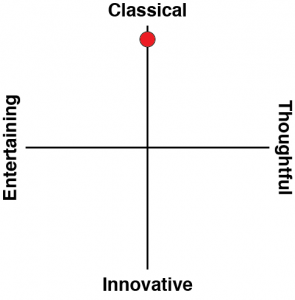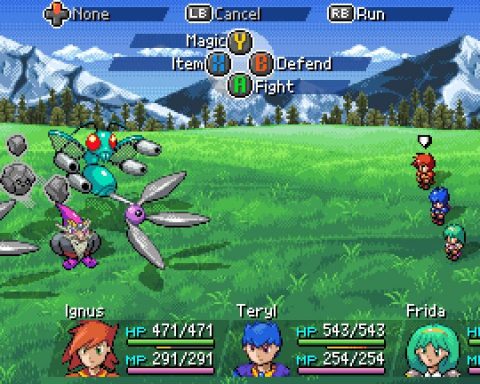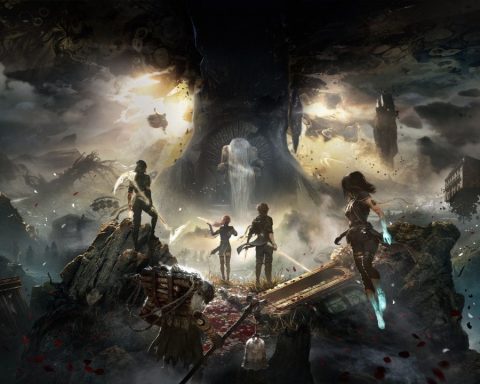One of the things I’ve learned in making my own visual novel is that scope can very easily blow out. Every new scene, character, idea, and story beat that you add in means more backgrounds, CGs, character costumes and music. Then it all becomes very expensive. And so, in most cases, you have to get creative and figure out how to make something that captures your intent and vision while also keeping a tight lid on scope. Project management has never been my strong suit. QUALIA ~ The Path of Promise ~ is a good example of some very clever visual novel project management.
This is a nicely efficient VN that will take you around 10 hours to read through. There are just a few characters that we ever see (two women, and the protagonist shows up in some CGs), and just a handful of CGs. Additionally, locations and events are limited. It’s impressive how limited the developers were able to keep the game. But then it also didn’t need to be more than that because the firm focus of the narrative is the relationship between the protagonist and a single android robot.
The protagonist is a genius scientist who has created the first robot to “pass the Turing Test”. She also happens to be built as a beautiful girl with an absolutely massive chest. The reason why this guy would build a robot with sex doll proportions is never really vocalised, and also perhaps the most unrealistic thing about the entire game. In the really real world, the first robots with proper AI smarts and personalities built into them are almost certainly going to be produced by Silicon Valley, and Silicon Valley’s deeply weird sense of ethics would lead it to make these robots entirely “realistic” in design (and soon after it would fire the entire team working on the robot project once their work on the robot was finished).
But anyway, the infuriating contradictory sense of ethics within Silicon Valley aside, in this game the protagonist won the robot race and clearly decided to also indulge his aesthetic preferences. After bringing her home, he proceeds to teach her about everything to do with life, and test her ability to learn, adapt, “remember” and improve.
There’s actually quite a lot of science wrapped up in QUALIA, and it’s filled with commentary on both the philosophy of AI design and the practical nature of machine learning. It’s a vast difference from something like, say, the Joi units in Blade Runner 2049, which simply exist with no explanation as to how. Preferences will vary, though I personally found the science talk to be a bit dry and run-on at times, but at least QUALIA isn’t so in love with its tech terms and explanations that the story loses momentum entirely.
As you’ve probably guessed, a romance does blossom between the two, and whether you ultimately like QUALIA will depend almost entirely on your tolerance for this. The game makes the argument that the truest test of artificial intelligence is whether a machine can understand and feel romance, so the writers technically sidestep the question of consent(or at least try to). However, she’s as naïve as a baby when she is first brought home, she’s dressed in a maid costume, is totally subservient to her creator-master human, and immediately the protagonist puts her to work cleaning the house, cooking, and undertaking other domestic chores. There’s a hardcore power imbalance in there and though the game does its best to paper over it, this may well make some players uncomfortable as the relationship turns romantic.
… Then again those people weren’t ever going to buy a game where the main female character is wearing a maid costume that barely contains her breasts, and one screenshot would have been enough to convince them of this game, so the point above is probably moot. However, what is more likely to annoy those who play this on Switch is the lack of explicit sex scenes, of which the PC version has several.
I don’t personally think this is a problem. In fact, I didn’t actually realise that there was an adults-only version of this until I was researching it for review, and if anything the narrative benefits from the sweeter tone it takes when it doesn’t have the money shots adding a pornographic quality to it. Also, having seen examples of the sex scenes from the sites that sell it, there doesn’t seem to be anything particularly aesthetically interesting about them. In this way, it’s a little like Nekopara where I think the right tone is that it’s fanservicey without being explicit. But I know there are plenty of others that really, really care about seeing genitals being shoved into other genitals (or mouths, or massive, heaving boobs squeezed together, or…), and so this Switch version is going to come across poorly to them.
Sex (or lack thereof) aside, QUALIA does have a compelling way about it. It’s written very nicely and the relationship and romance between the characters is convincing and earnest. We do live in a world where AI and both digital characters and robots are going to make digisexuality rapidly accelerate towards mainstream awareness and, in the longer term, acceptance (yes, digisexuality is a real term). So there’s actually a lot to talk about in terms of how we as a society handle and integrate that. QUALIA hasn’t been written to contribute to the discussion, but its existence makes it a point of interest to the discussion, and it’s worth playing as we start wrapping some thoughts around it.
Because make no bones about it, we as a society are going to need to have a discussion about digisexuality. Neil McArthur & Markie L. C. Twist overviewed the nature that the discussion would take with their paper The rise of digisexuality: Therapeutic challenges and possibilities: “This development is likely to provoke considerable alarm among social commentators, who will worry about the disappearance of large number of people from the romance market, and about their retreat into a world of digital-only sexual experiences. There has already been much discussion of the Japanese men who allegedly prefer the romantic companionship of video game characters to humans (see Glascock, 2015; Rani, 2013). Digisexuals will undoubtedly face a certain amount of stigma for their identity and related practices, in the way that those with minoritized sexualities and identities inevitably have (see Twist, Belous, Maier, & Bergdall, this issue, for more on the effect of stigmatization on lesbian, gay, and bisexual individuals and on their partnered relationships). However, this stigmatization must be recognized and combated. We believe that we will have a responsibility to respect the identities of digisexuals, and to ensure that these people do not become marginalized as a result of their sexuality and related practices.”
On the other side of the discussion there will inevitably be people that discuss digisexuality as a form of supernormal stimulus, in the same mold as pornography, and will worry about the impact that has on people and their ability to interact with other “real” people. It’s going to be a fascinating discussion as more and more people start to identify as digisexuals.
I went into QUALIA expecting it to be a fairly run-of-the-mill big boob fanservice game. And in some regards it is. It’s not really breaking new ground on how these stories are told. On the other hand, the subject of the game is inherently interesting and highly topical, and while the presentation is very familiar, it’s exactly what the target audience likes to see. It’s also an impressive example of how to build a visual novel on a minimal budget without needing to make concessions to the goals of the project. The android at the heart of QUALIA might not be my idea of the ideal love robot, but I certainly enjoyed the opportunity to learn more about her here.
Buy the hottest games with Amazon.
By purchasing from this link, you support DDNet.
Each sale earns us a small commission.














